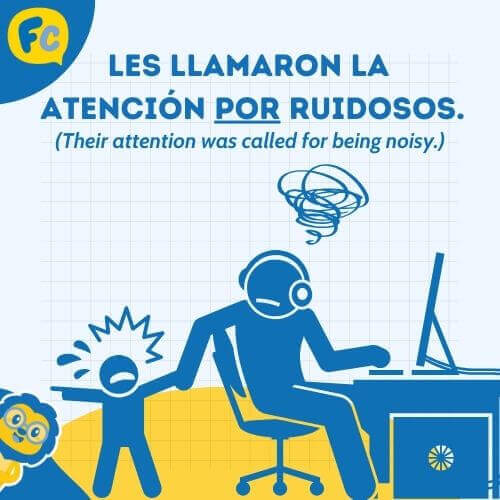Is It Por or Para in Spanish? Two Distinct Yet Similar Spanish Prepositions
Why Por or Para Aren’t Just the English Equivalent of “For”

Por and para are Spanish prepositions generally translated into English as “for”.
However, this is a very limiting translation, as there is a far more extensive and correct usage in Spanish for both por and para, each serving a distinct function and context-dependent.
👉 So, hang in there, this article is all about good (Spanish) grammar, aiming to eliminate those doubts and shed light on whether to use por or para at any given time!
Some examples of prepositions in English are words like “by”, “at”, “to”, “in”, “on”, “among”, “off”, “onto”, etc. For a complete list in Spanish, these are the current-day accepted prepositions (por and para inclusive):
a, ante, bajo, cabe, con, contra, de, desde, durante, en, entre, hacia, hasta, mediante, para, por, según, sin, so, sobre, tras, versus y vía.
Full disclaimer: Due to historical reasons, the Spanish prepositions por and para have a very interrelated usage, hence they may often overlap, in spite of their distinctive functions.
Both por and para derive from the Roman-Iberian preposition “por”, which was used to indicate, among others, cause or objective and express movement through a place, somehow reminiscent of the current day usage of por and para.
✨ Let’s break down ‘Por’ or ‘Para’ in Spanish with us ✨
Por or Para || The Spanish Preposition Por
Por or Para || The Spanish Preposition Para
Por or Para || Key Differences Between Por and Para
Por or Para || Quiz
Por or Para || FAQs
Por or Para || The Spanish Preposition Por
The Spanish preposition por is generally used to express a course or trajectory and an imprecise or undetermined location or time.


| USING POR TO EXPRESS… | EXAMPLE |
|---|---|
| a course or trajectory: |
Conducían por la carretera
They were driving by the highway |
| an approximate location: |
Ellos estaban por la grada sur del campo de fútbol
They were in the south bleachers of the football stadium |
| an approximate time: |
Ella nació por los años ochenta
She was born around the eighties. |
| indicate the cause or motive behind an action. |
Les llamaron la atención por ruidosos.
Their attention was called for being noisy Él lo hizo por despecho He did it out of spite. |
Other main uses of the Spanish preposition por include:
| POR IS USED TO INDICATE… | EXAMPLE |
|---|---|
| the agent in passive voice constructions as it identifies the “doer” of the action. |
El manifiesto fue firmado por todos.
The manifesto was signed by all. |
| the means/resources used for a certain action. |
El ejército tomó la ciudad por la fuerza.
The army took the city by force. |
| the instrument through which something is sent or received. |
He recibido el paquete por correo aéreo.
I received the package through air mail. Llámale por teléfono. Call him through the telephone. |
| the quantity by which something is bought or sold. |
Lo compré por veinte euros.
I bought it for twenty euros. Ellos los vendieron por mucho dinero. They sold it for a lot of money. |
| the person or thing substituting another. |
Su hermana cantará por él.
His sister will sing for him. Recibí mil euros por el coche. I received one thousand euros for the car. |

📌 Por is also used to indicate the duration of time (although this use is more common in American Spanish vs European Spanish wherein the preposition durante (“during”) is more frequently used instead.
Estaré en España por dos semanas.
I will be in Spain for two weeks.Por can also be used to refer to a person that does not object to something, that is indifferent.
| SPANISH | TRANSLATION |
|---|---|
| Por mi, que se lo queden. | As far as I am concerned, they can keep it. |
| Si fuera por ellos, aún estaríamos aquí. | If it were up to them, we would still be here. |

How to Use ‘Y’ in Spanish: Simple Rules & When to Use ‘E’
Y in Spanish: Where the Y Is Located Makes All the Difference In Spanish, “Y” is much more than just a simple letter. Most commonly, “Y” serves as a conjunction, equivalent to the English word “and,” helping to link words,…
Por or Para || The Spanish Preposition Para
The Spanish preposition para is generally used to express a destination, both in the physical and in the figurative sense.
Vamos para mi pueblo.
Let’s go to my town.Other main uses of the Spanish preposition para include:
From a time-based perspective, para also indicates the limit wherein something will occur.
| SPANISH | TRANSLATION |
|---|---|
| Lo tendré acabado para el mes que viene. | I will have it finished by next month. |
| Tiene que estar preparado para el viernes. | It has to be ready by Friday. |
One of the most characteristic uses of para is to indicate an objective or purpose of something.
| SPANISH | TRANSLATION |
|---|---|
| Esta ensalada es para comer hoy. | This salad is to be eaten today. |
| Me fui a casa para descansar. | I went home to rest. |

Other closely related to the above uses are those wherein para:
indicates use or service:
| SPANISH | TRANSLATION |
|---|---|
| Para el ver partido, he preparado un aperitivo | To watch the game, I prepared an appetizer. |
| Un rato para dormir | A moment to sleep |
| Ropa para vestir | Clothes to wear |
| Pinceles para pintar | Brushes to paint / paintbrushes |
indicates orientation/intention of certain actions:
| SPANISH | TRANSLATION |
|---|---|
| Ella estudia para sacar buenas notas | She studies to get good grades. |
| Practican tocar el piano para el concierto. | They practice playing the piano for the concert. |

indicates the recipient of an action or an object:
| SPANISH | TRANSLATION |
|---|---|
| Ellos cocinaron la cena para todos. | They cooked dinner for everyone. |
| Este regalo es para ti. | This gift is for you. |
Other uses of para are those that justify or clarify a statement:
| SPANISH | TRANSLATION |
|---|---|
| Para ser claros, no ha sido él. | To be clear, it wasn’t him. |
| Para ser justos, ella se esforzó mucho. | To be fair, she put in a lot of effort. |
Por or Para ||
Key Differences Between Por and Para
Although the Spanish prepositions por and para can tend to overlap, often being used interchangeably, there is a proper grammatical use of each.
Distinctions between por and para are nuanced and many times context-based. However, as a general basis to loosely distinguish between the use of the prepositions por and para, we can bear in mind these key differences:
Por is commonly used to express the cause, means or motive of an action. So, in a way, the preposition por generally gives us a glance at past occurrences or events.
Para is generally used to indicate a destination or to express an objective, aim or purpose. So, in contrast, the preposition para usually points forward, to future occurrences.
Now you’ve mastered ‘Por or Para’ , why not check out these Spanish essentials?
Por or Para || Quiz
Por or Para || FAQs
Is por or para used more often in Spanish?
In comparison, the Spanish preposition por is among the ones that have the most usage as well as context-based distinctions/values of use.
So a trick to know when to use either would be to learn the fewer rules of use for the preposition para, making it easier to assume that – grammatically speaking – one can default to por when those fewer rules for para do not apply.
What is the difference between the Spanish prepositions por and para?
Por is generally used to express the cause, means, or motive of an action or movement through something. A grammatical clue to look out for would be that por usually comes hand in hand with a verb that likewise implies cause, motive or movement.
Para is generally used to indicate a destination or to express an objective, aim or purpose. A grammatical clue to look out for would be that para usually comes hand in hand with a verb that likewise indicates direction towards an objective, purpose or aim.
Can por and para in Spanish be used interchangeably?
Well, according to the foremost authority in the Spanish language, the Real Academia Española, in the current day usage of Spanish, both prepositions por and para are often interchangeable in a large number of contexts.
However, said authority also distinguishes the correct contextual and grammatical use of each preposition (por and para) for proper use of the Spanish language.
How do I know when to use por and para?
When deciding which preposition to use (por or para), pay attention to the context and meaning you wish to convey.
As part of the contextual clues to look out for, remember that:
por is most commonly used with verbs that express cause, motive or movement:
para is most commonly used with verbs that express the objective, purpose or aim of an action.
What is the difference between por and porque in Spanish?
While both por and porque can be used to indicate cause or reason, there are in fact key differences between the two words.
Por is a preposition mainly used to indicate the cause, or motive of an action or movement through something, so a grammatical clue to look out for would be that por is followed by a noun, pronoun or noun phrase.
Porque is a conjunction that is mainly used to introduce phrases that express cause or reason (equivalent to “because” in English), so a grammatical clue to look out for would be that porque is followed by a verb.
Want More From LTL?
FANCY LEARNING SPANISH? Check out our online Spanish courses here.
We offer a 7-day free trial to all online students where you can study Spanish 24/7. It doesn’t end there either.
We teach over 10 of the world’s most popular languages 😎
Come and be a part of our amazing community.










